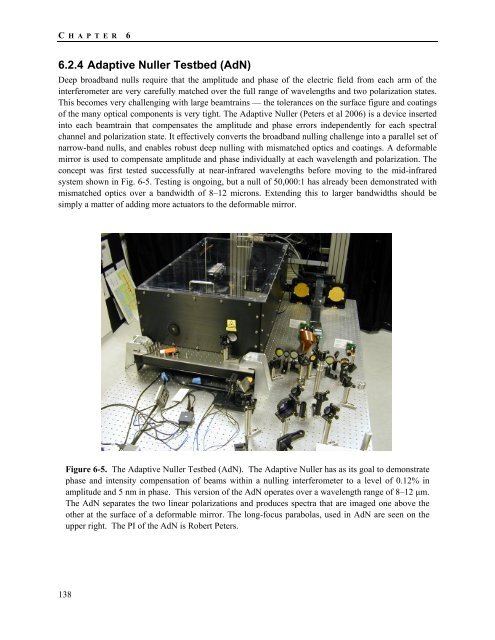TPF-I SWG Report - Exoplanet Exploration Program - NASA
TPF-I SWG Report - Exoplanet Exploration Program - NASA
TPF-I SWG Report - Exoplanet Exploration Program - NASA
Create successful ePaper yourself
Turn your PDF publications into a flip-book with our unique Google optimized e-Paper software.
C HAPTER 6<br />
6.2.4 Adaptive Nuller Testbed (AdN)<br />
Deep broadband nulls require that the amplitude and phase of the electric field from each arm of the<br />
interferometer are very carefully matched over the full range of wavelengths and two polarization states.<br />
This becomes very challenging with large beamtrains — the tolerances on the surface figure and coatings<br />
of the many optical components is very tight. The Adaptive Nuller (Peters et al 2006) is a device inserted<br />
into each beamtrain that compensates the amplitude and phase errors independently for each spectral<br />
channel and polarization state. It effectively converts the broadband nulling challenge into a parallel set of<br />
narrow-band nulls, and enables robust deep nulling with mismatched optics and coatings. A deformable<br />
mirror is used to compensate amplitude and phase individually at each wavelength and polarization. The<br />
concept was first tested successfully at near-infrared wavelengths before moving to the mid-infrared<br />
system shown in Fig. 6-5. Testing is ongoing, but a null of 50,000:1 has already been demonstrated with<br />
mismatched optics over a bandwidth of 8–12 microns. Extending this to larger bandwidths should be<br />
simply a matter of adding more actuators to the deformable mirror.<br />
Figure 6-5. The Adaptive Nuller Testbed (AdN). The Adaptive Nuller has as its goal to demonstrate<br />
phase and intensity compensation of beams within a nulling interferometer to a level of 0.12% in<br />
amplitude and 5 nm in phase. This version of the AdN operates over a wavelength range of 8–12 μm.<br />
The AdN separates the two linear polarizations and produces spectra that are imaged one above the<br />
other at the surface of a deformable mirror. The long-focus parabolas, used in AdN are seen on the<br />
upper right. The PI of the AdN is Robert Peters.<br />
138
















